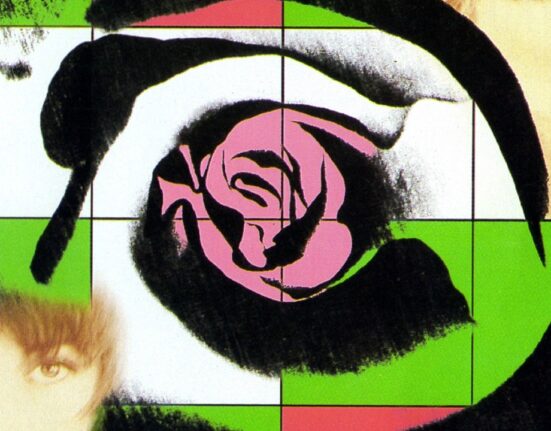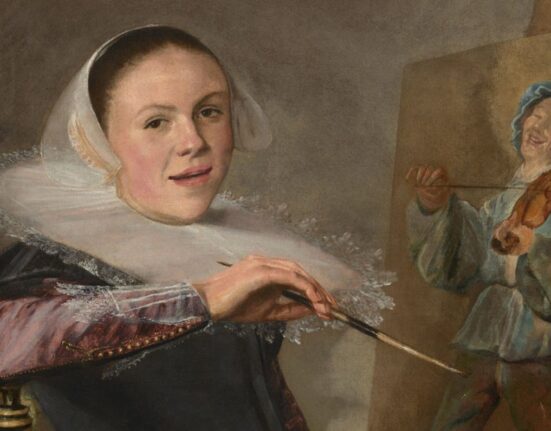Art
Sandra Hale Schulman
Installation view of Rose B. Simpson, “Skeena” at Jessica Silverman, 2023. Photo by Philip Maisel. Courtesy of the artist, Jack Shainman Gallery, New York, and Jessica Silverman, San Francisco
The five figures by Rose B. Simpson at the Whitney Museum of American Art are showcased in an outdoor gallery. Cast in concrete, these striking sculptures have hollowed-out eyes that let the light pass through. The statues serve as watchful spirits of the Lenape, the original Indigenous inhabitants of Manhattan. Looking over the city they once ruled, they are stone-faced in silent judgment.
“Counterculture,” on view at the Whitney through January 21, 2024, is a series of works that were originally shown at Field Farm in Williamstown, Massachusetts. It’s one of multiple outings for the artist this fall season: On the opposite coast of the U.S., she also has a solo show at Jessica Silverman, “Skeena,” on view through December 23rd. “Those beings that are standing in the city had a different intent, as they were originally made for Field Farm in Massachusetts,” Simpson said, in an interview with Artsy. “I was wondering how well they would do, how they would hold their own in a space like that.”
Rose B. Simpson Daughter 1, 2023. Photo by Addison Doty. Courtesy of the artist, Jack Shainman Gallery, New York, and Jessica Silverman, San Francisco
Portrait of Rose B. Simpson, by Minesh Bacrania. Courtesy of the artist, Jack Shainman Gallery, New York, and Jessica Silverman, San Francisco
Simpson grew up in Santa Clara Pueblo, a Tewa tribal community next to the predominantly Latinx town of Española, New Mexico. Over the last few years, she has been fast gaining art world attention, exhibiting at major museums from coast to coast including The Heard Museum in Phoenix and the Hirshhorn in Washington, D.C., as well as at Jack Shainman Gallery in New York.
Simpson comes from a long line of ceramists and even performed in Native American punk rock bands before earning an MFA in art at the Rhode Island School of Design. Her rise in the art world can be attributed to her distinct ceramic and clay work that revolves around the self, rather than focusing solely on broad political, tribal, and social issues relating to Native American identity.
Rose B. Simpson, Alter-Piece, 2023. Photo by Philip Maisel. Courtesy of the artist, Jack Shainman Gallery, New York, and Jessica Silverman, San Francisco
Rose B. Simpson, Two Selves, 2023. Photo by Addison Doty. Courtesy of the artist, Jack Shainman Gallery, New York, and Jessica Silverman, San Francisco
“I’ve had work on both sides of the country before, but never simultaneously,” the artist said. The show at Jessica Silverman contains 10 pieces—nine figures and one large wall work entitled Alter-Piece (2023), a bas-relief triptych comprising a mask at the center, ceramic shards, and clay sticks. Is it an altar, a battle scene, or, perhaps, a map to the self? The work resists direct explanation, leaving its placement and iconography open to interpretation.
The show’s central work is entitled Two Selves (2023) and consists of two figures: one adult-sized, armless figure, with a childlike creature with outstretched hands and kicking legs bound to its chest. Hanging around the figure’s waist is a twine belt, dangling with small, painted talismanic objects. The sculpture, which Simpson sees as part of a dialogue with the wall piece, marks a turning point in her practice. It’s the first self-portrait she’s made since 2016: “Even though everything I make is a version of myself, this one’s a very intentional self-portrait that is reaching for this reflection of itself.…The tension in the whole show is between that piece and the wall piece,” she said.
Installation view of Rose B. Simpson, “Skeena” at Jessica Silverman, 2023. Photo by Philip Maisel. Courtesy of the artist, Jack Shainman Gallery, New York, and Jessica Silverman, San Francisco
Beyond this dialogue of two works, other figures create a cast of characters, all facing the same direction. Some are created from stacked torsos; others from painted black statues with white stripes across their bodies and heads, their hands hanging from elongated arms made of twine. These sculptures, Simpson explained, represent the community of this central figure: “Her skin, her crew, her squad, her gang, her family, her support system: Her ‘skeena.’”
This word, which titles the show, is a Latinx slang term meaning “gang,” Simpson explained: “‘Skeena,’ where I come from, is your crew.…It’s the people in your corner, your roll dogs, your squad. The people that would throw down for you.”
The idea has long inspired the artist: “I’ve been excited about this concept for a while, sniffing out where this would come to life,” she said. It was only when she came to Jessica Silverman for support, she said, that she was able to realize the installation fully. “I was happy that she was willing to do a show [of] individual pieces that all create a specific concept. The idea was about how often we forget that we’re not alone in our journey, in our life. We have accountability, but we also have all the support.”
Rose B. Simpson, Daughter 2 , 2023. Photo by Addison Doty. Courtesy of the artist, Jack Shainman Gallery, New York, and Jessica Silverman, San Francisco
Rose B. Simpson, Reception, 2023. Photo by Addison Doty. Courtesy of the artist, Jack Shainman Gallery, New York, and Jessica Silverman, San Francisco
The placement of figures in the show reflects this approach: All figures face the wall work except for the central figure that represents the artist herself. “I consider that we’re all connected. Every single being, every single thing on this planet,” the artist said. “Whenever I make a piece of art, it’s a piece of me. Even if it’s a portrait of someone else, it’s a moment of my empathic response.” This work, she said, was particularly personal, which meant it was difficult to make. She noted that she was “considering myself very specifically and my fears and all the different emotions that I carry around this journey that I’m on. It was difficult to put that into the work.”
Ultimately, the artist explained, this show was about taking risks. “You have to push yourself,” she said, asking, “What are my fears? That people would think I’m totally nuts? What am I trying to hide?”







